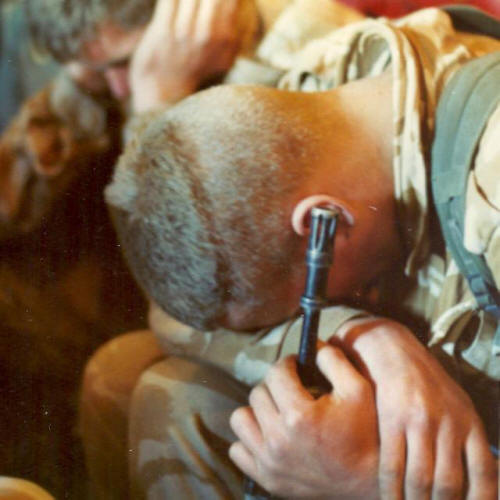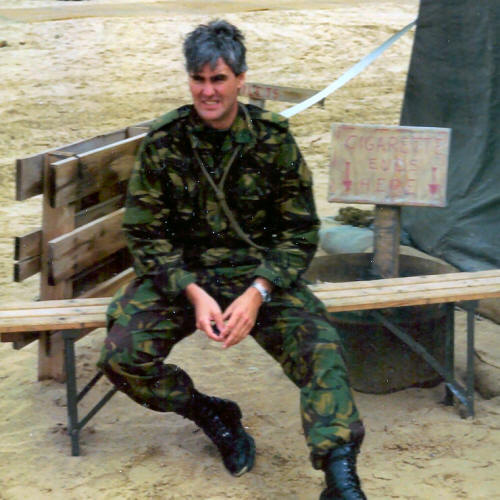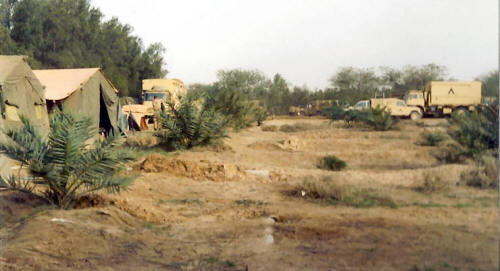|

WITH THE
Kuwait War over, life in HQBFME became increasingly
tedious as we all waited to hear when we might be able
to go home. However, one important task we had to
complete was the compilation of the Post Operations
Report (POR).
Like many other organisations, the British Army tries
hard to review what has happened in training or on
operations to collect the lessons learned for future
endeavours. Unlike the Fire Service or the Police, say,
the army may only ply its trade for real intermittently
and when it does it’s always useful to know what went
right, or indeed wrong.
The problem is, of course, that there is no guarantee
that the next war will be the same as the one before,
and it’s probably fair to say that the army often enters
the next one perfectly prepared for the last one. The
Second World War is probably the most egregious example
of this (despite having developed new theories of mobile
warfare using the tank – Ed.), but much the same could
be said of subsequent adventures in Iraq and
Afghanistan. There is no easy solution to the conundrum.
Nevertheless, it would be a foolish organisation which
did not at least attempt to learn lessons from past
successes and failures, so we set to. A team of about
twenty or so assorted arms and services representatives
was sent forward from HQBFME in Riyadh to visit the
British units in the field and quiz those who had been
closest involved in the fighting before memories dulled.
So we flew from Riyadh to Al Jubail in an RAF Hercules,
which was pleasant enough, but it was raining when we
arrived at our interim stop. The aircraft then developed
a fault and we could well have become stuck. If it had
been peacetime we undoubtedly would have been, for the
RAF was notoriously slow and inefficient in those days
when it came to fixing their passenger transport
aircraft.

However,
one of the joys of being on operations was that air
transport was able to throw off the shackles of
peacetime procedures and operate properly. If you wanted
to go somewhere, and there was a ‘plane going there with
some room on it, you got on, as simple as that. The
loadmaster might ask you if your gun was unloaded before
you boarded, but that was it. What a relief it was from
the tiresome bureaucracy of RAF peacetime transport
arrangements!
Anyway, there was an RNZAF Hercules on the strip and it
was available for tasking, so we transferred to that
lock, stock, and barrel for onward passage to Kuwait
International after a two hour pause. The NZ crew were a
bit hacked off, to be honest, because they had been
about to go off duty after a normal shift, but they hid
it very well. They had an extremely laconic Sergeant
Loadmaster who addressed everyone as “mate”, of course,
who rather amusingly apologised for the lack of an
in-flight movie during his pre-flight briefing, a joke I
suspect he had told numerous times before, but it made
me laugh anyway.
In the end they delivered us safely and without further
incident to Kuwait International, despite the restricted
visibility from the oil wells the Iraqis had set alight
during their retreat, and we were all very grateful. The
airport was a mess and presented a desolate spectacle as
we deplaned. There was a burned out airliner close to
our arrival point and the runways were strewn with
shrapnel. Every pane of glass in the large terminal
building seemed to have been broken and it looked as if
the place had been thoroughly looted.
We didn’t have time to explore further, though, for
shortly we heard the clatter of helicopters, and two or
three RAF Puma aircraft hove into view, landed, and
taxied up to collect us. Our party then split into
smaller groups and headed off to visit various units
scattered across northern Kuwait. I and several others
were bound for the 1 (UK) Armd Div HQ, located some
dozen miles or so beyond the outskirts of Kuwait City,
on the way north to the Iraq border and Basra.
As we flew across the city I noticed that there were
quite a few abandoned Iraqi tanks and other vehicles by
the sides of the roads, both in the centre of the town
and in the residential suburbs. Nothing had prepared me,
though, for the scene outside the city on the main
highway north. We flew at about 200 feet over what had
become known as “Death’s Acre” or the “Highway of Death”
– the few kilometres of the motorway where Coalition
aircraft had trapped the fleeing Iraqis and destroyed
everything in continuous air attacks.
Although I had previously seen television pictures of
the carnage, the reality was much worse. All lanes of
the highway were blocked by destroyed and burnt-out
vehicles, noses pointing north, and the roadsides and
far out into the desert were littered with the detritus
of a defeated army in headlong flight. The Iraqis had
clearly commandeered anything that moved in their panic
to escape, for amongst the tanks and trucks were large
numbers of civilian cars, vans, and buses, similarly
blackened by fire.
Worse still, in many ways, was the evidence that all
these derelict vehicles had been thoroughly looted, for
each wreck was surrounded by a little pitiful pile of
possessions which lay where the scavengers had discarded
them. More than anything it was reminiscent of a large
refuse dump, and to view it was hardly an uplifting
experience. There was certainly no sense of triumph or
victory as we flew over.

Our
Divisional HQ was in a plantation on the coast just
north of Kuwait City, comfortable enough as far as
living in the desert goes. It consisted of the usual Ops
tent complex, plus a ragtag collection of tents, trucks,
and assorted military and civilian vehicles parked in
among the scruffy palm trees. I knew quite a number of
the staff, and they seemed to be in fine fettle, if a
little weary, and very pleased it was all over. I spent
some time working with them, and then turned in for the
night in a small tent shared with two others, a tight
squeeze exacerbated by the fact there seemed to be a
complete arsenal of captured Iraqi weaponry in there
too!
The next day I headed back to Kuwait airport, driven by
Regimental chum Duncan MacMillan, who had been seconded
to Div HQ as a watchkeeper, in a civvy Range Rover that
he had purloined from somewhere. I bade him farewell at
the terminal and would next see him back in Germany. I
found my way to a temporised check-in desk where a
cheerful RAF corporal with his feet up on the desk
invited me to dump any illicit Iraqi weaponry I had on
me in a box next to him and then allocated me to an
aircraft. This last action wasn’t too difficult for him,
for there was a strictly limited number of destinations
and if there was a flight going in your direction you
got on it.
The same friendly NZ Hercules crew were flying me again,
and my fellow passengers included a company of Queen’s
Own Highlanders who has just come out of the desert (and
were exhausted) plus a few other odd individuals. There
was also an extraordinarily pretty blonde American girl
on board, from one of their National Guard units I
think. Halfway through the trip to Al Jubail she
disappeared into the crew cabin, and after about five
minutes the aircraft began a series of turning and
banking manoeuvres which the routine flight didn’t call
for.
Sure enough, the girl was the pilot’s current par amour
and he was taking the opportunity to give her some
impromptu flying lessons, allowing her to take control
(under supervision I hope). I wouldn’t imagine for one
minute that such practices were allowed even in the
RNZAF, but nobody complained – we were all too tired
anyway – and no-one in authority was ever the wiser. It
made for an interesting interlude on an otherwise rather
dull journey, and I was sad to see her leave the ‘plane
at Jubail.
The remainder of the flight back to Riyadh was
uneventful. My old friend from Staff College Jonathan
Campbell-James was on the same flight and had arranged
for a driver from the British Embassy to pick him up at
the airport, so he kindly offered to give me a lift into
town. On the way we diverted to his house inside the
Embassy compound for a couple of real beers before his
driver deposited me back at the Marriott. This was to be
my last trip up country, and the next time I saw the
airport was to be on my way out of Saudi Arabia. The
boys in the desert, meanwhile, had a little bit more
time to kick their heels before they too headed back
home.
To come in Part 29; going back to Germany. |
